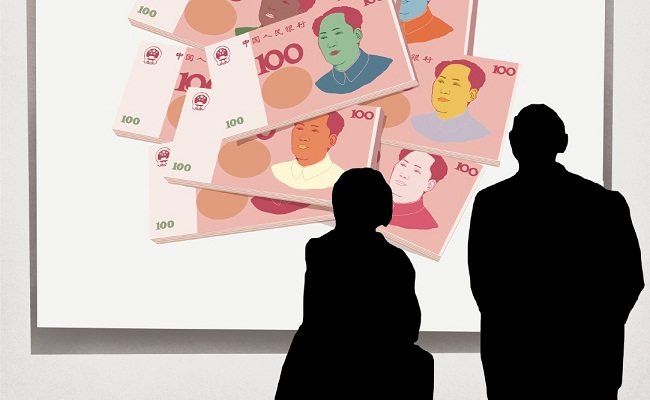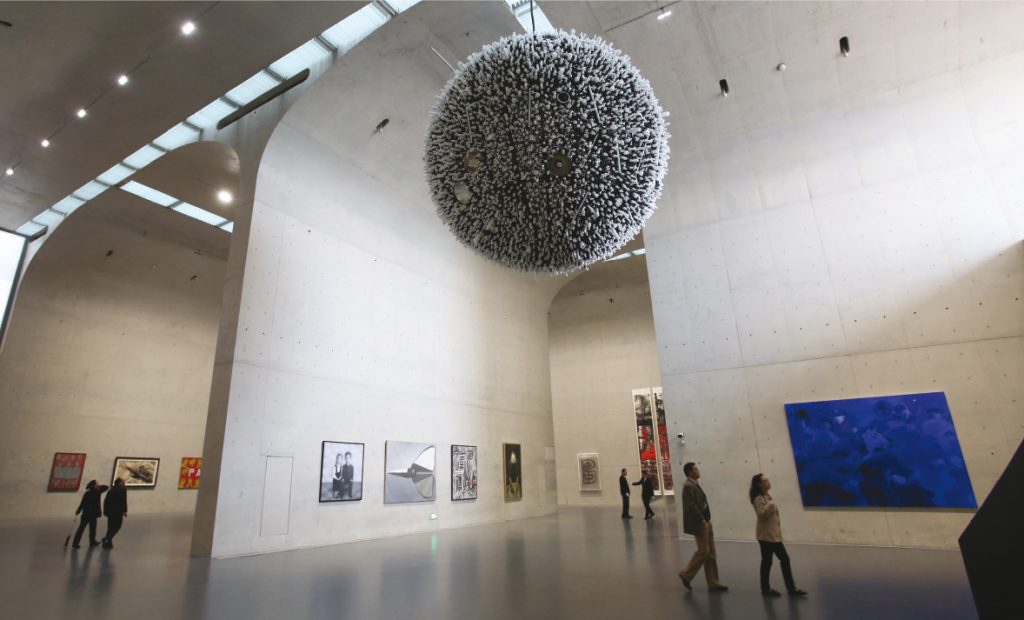
The burgeoning Chinese art market means serious money, and also a richer cultural scene.
Half an hour before closing time on a characteristically dreary and polluted Sunday in January, about two dozen people—mostly Chinese couples in their 20s—have sought shelter by meandering through the stark, airy rooms of the West Bund branch of Shanghai’s Long Museum. Except for traveling exhibitions, all of the art in both this museum and the Long Museum’s Pudong branch is owned by boisterous self-made billionaire Liu Yiqian.
Tucked in a corner lies the contemporary Chinese painting section, a who’s-who of the biggest living Chinese artists and their work, some of which is surprisingly political to be displayed here on the mainland, like Wang Ziwei’s 1996 painting Hopeless: Greeting, which depicts Mao waving to a crucified Jesus in saturated primary colors. Hanging nearby is one of Yue Minjun’s self-portraits with his famous eerie grin—1994’s On the Lake, next to Liu Ye’s 1995 work Golden Avenue, in which two Chinese children with wings dance under a rainbow as a flaming airplane plummets to earth in the background.
“At the beginning, Chinese collectors would only be interested in works thinking in terms of decorating their homes,” says Yu Hong, an oil painter from Beijing who has sold several of her paintings to Liu Yiqian for display in the Long Museum. “The beginning” is the early 80s, when Yu was an art student at the China Central Academy of Fine Arts (where she now teaches) and China was in the initial stages of opening its economy. “Now,” she says, “they are establishing comprehensive collection systems and their own private museums.”
Though the Long Museum West Bund was the largest private museum in China when it opened in 2014 and remains a gem of Chinese contemporary art, it’s not the reason Liu has been making international headlines. Western newspapers began covering the tycoon when he caused a scandal in April 2014 by spending $36.3 million on a 500-year-old Ming Dynasty cup, known as the Chicken Cup, and then sipping tea out of the historic piece of porcelain. In November 2015, he spent $170.4 million, the second-largest amount ever spent on an artwork bought at auction, on the purchase of Nu Couché by Italian painter Amedeo Modigliani.

Liu and Chinese collectors like him are driving the attention of both the media and the world’s biggest auction houses toward China, but the nation’s art scene is also flourishing domestically as Chinese artists gain international acclaim and both galleries and museums open all over the country—China has seen over 100 new museums a year every year since 2008. In 2015, Shanghai especially experienced rapid development on all levels—in terms of large-scale museums, high-profile touring exhibitions and grassroots support for young artists and forward-thinking work.
Masters of the Art
Liu Yiqian is the most infamous of China’s art collectors, but there are many others making an impact on the market worldwide. According to the 2015 edition of the TEFAF Art Market Report, the global art market reached €51 billion ($62 billion) in 2014. The US had the highest percentage of the market at 39%, while China and the UK were tied for the second highest at 22%. This Chinese presence in the market is a relatively new phenomenon—in 2000, China had less than 1%, according to Citi.
The major Chinese art buyers are a handful of ultra-rich businessmen. May 2014 saw Huayi Brothers Media Group Chairman Wang Zhongjun drop $66.3 million on Van Gogh’s L’allee des Alyscamps (“Some people simply want to fall into a reverie, cigar in hand, staring at a painting,” he told auction house Sotheby’s in an interview explaining his purchase), while Dalian Wanda Group, which is owned by one of China’s richest men, Wang Jianlin, has several times spent tens of millions on 19th and 20th century European artwork.
But Liu outdid them all with his Modigliani purchase, and has been vocal about his reasons for collecting modern European art. In a November 2015 interview with The New York Times about the painting, he said: “The message to the West is clear: We have bought their buildings, we have bought their companies, and now we are going to buy their art.” His wife, Wang Wei, is also a collector who focuses more on the buying of the contemporary Chinese art that fills their two Long Museum branches.
Based on sales figures, early 20th century European art is most coveted by Chinese collectors, though Chinese contemporary art is undeniably on the rise. Many of today’s most established Chinese artists, like Wang Ziwei, Yue Minjun (whose 1993 painting Gweong-Gweong sold at auction in 2008 for just under $7 million, ranking it as one of the top 10 all-time sales at auction of a work by a Chinese artist) and Liu Ye owe a good portion of their success to Western collectors, who began purchasing their works in the 90s.
“Art created during each stage of the remarkable post-1979 change that China has undergone captures a moment in history that will never happen again,” says Claire Van Den Heever, author of Paint by Numbers: China’s Art Factory from Mao to Now. “Potentially high returns on investments in contemporary Chinese art are one part of the picture, [but] Western interest undoubtedly went beyond money, too.”
According to the Fine Art & Design Price Database from Artnet.com, Chinese fine art pieces totaled $4.4 billion at auction in 2014, a sum that contributed approximately 25% to the global auction market that year. The highest-ranking Chinese artist of 2014, Qi Baishi, ranked sixth overall among fine artists that year.
Trickling Down and Bubbling Up
China’s spate of new museums, most notably in Shanghai, Beijing and Nanjing, are in many cases spearheaded by wealthy young collectors like Adrian Cheng, the Chairman of Shanghai’s K11 Art Foundation and one of the world’s youngest billionaires. The mainland’s first Claude Monet exhibit was held in March 2014 at K11’s Chi Art Space, while the internationally celebrated Rain Room opened at Shanghai’s Yuz Museum (a private museum owned by prominent Chinese-Indonesian collector Budi Tek) this past fall.
2015 was an especially developmental year for Shanghai thanks to a purposeful government venture called the West Bund Initiative. West Bund now rivals New York’s Museum Mile in terms of density—when the Oil Tank Art and Performance Center opens in 2017, there will be six museums on the strip. Even so, this lightning speed of development and deep government involvement has raised some eyebrows in the art world.
“The scene has grown significantly in size and reach, and some of that has included ‘organic’ growth,” says Van Den Heever. “But it is worth distinguishing this growth from the (often insincere and shallow) state-funded efforts to ‘create’ innovation through cultural hubs and similar projects.”
The organic growth of Chinese art may be bubbling up elsewhere, however. From the galleries in Beijing’s long-running 798 Art District to the privately-owned small ventures scattered throughout Shanghai, some Chinese cities are developing an underground art scene as their mainstream one solidifies, in a similar fashion to their international counterparts decades ago. “In every art district, you now find dozens if not hundreds of galleries searching for new artists,” says Yu.
Joseph Zhang, 25, an artist based in Shanghai who made his gallery debut last year as part of annual LGBT festival ShanghaiPRIDE, describes a supportive atmosphere for young artists fueled by word of mouth and crowd-sourced event promotion on sites like Douban.
“It’s a good time now in Shanghai if you’re an artist,” he says. “You meet someone through someone else, and people don’t judge you for your age or your background; they just care about what you’re doing.”
The smaller-scale galleries that nurture up-and-coming artists like Zhang vary from established names like Hong Kong gallery owner Pearl Lam, who exhibited a group show of leading contemporary Chinese female artists in Fall 2015 at her Shanghai showroom, to locally-owned spots like Leo Xu Projects, which displayed a slick photography installation exploring China’s youth and nightclub culture by Beijing-based artist Chen Wei this past winter.
These happenings couldn’t seem farther from Liu Yiqian and his larger-than-life purchases, but they’re part of the same developmental cycle. After all, less than 30 years ago Yu Hong was an art student who “could only get badly printed catalogues or look at old foreign magazines to find out about the greater art world.” Now, her paintings are on rotation in the Long Museum West Bund, where Liu has stated that he’ll eventually display Nu Couché.
“The contemporary art of any country is a sort of compressed expression of that country’s contemporary cultural situation,” says Yu, “and this is a time of upheaval.”



















